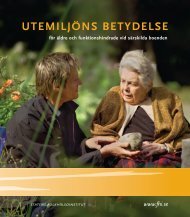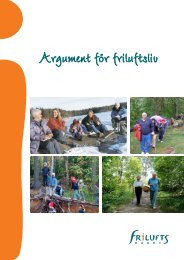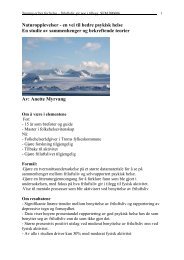Green Care: A Conceptual Framework - Frisk i naturen
Green Care: A Conceptual Framework - Frisk i naturen
Green Care: A Conceptual Framework - Frisk i naturen
You also want an ePaper? Increase the reach of your titles
YUMPU automatically turns print PDFs into web optimized ePapers that Google loves.
The treatment of tuberculosis during the 18th and 19th centuries also<br />
invoked the use of fresh air and sunlight as curative agents (Bird, 2007).<br />
Typical Victorian asylums included outside design features called ‘Airing<br />
Courts’ (walled areas which adjoined the house and were divided into<br />
sections for patient use), grounds for leisure, sports grounds, fields and<br />
sometimes as estate farm. An ethos of asylum regimes featured exercise and<br />
work out of doors and remained so until the mid 20th century (Bird, 2007).<br />
In the same vein, hospitals for more general physical diseases were also<br />
designed with grounds for aiding patient convalescence. Gardening work<br />
was seen as a way of helping people who were recovering from physical<br />
injuries to strengthen and build up damaged bones and muscles. In his<br />
book, The Rehabilitation of the Injured, Colson (1944) describes different<br />
gardening activities that may be used as therapy and lists specific activities<br />
to develop movement in particular joints (pp. x-xvi).<br />
As rehabilitative medicine and care developed, gardening was used to<br />
‘treat’ not only the physically injured but also those with mental health<br />
problems and learning difficulties. It became one of the ‘specific activities’<br />
of occupational therapy as the discipline developed in the 1950s and 60s<br />
and it is still used today. However, the activities used in occupational<br />
therapy have tended to vary according to the availability of facilities and<br />
changing attitudes and it is not known how many occupational therapists in<br />
the UK currently use gardening.<br />
During the 1940s several Therapeutic Communities were established in<br />
rural, farm settings, where the benefits of nature were recognised as being<br />
integral to the therapeutic experience. Therapeutic communities (TCs) are<br />
group-based treatment programmes (i.e. providing group psychotherapy)<br />
which first came to existence in the UK during the Second World War and<br />
now exist in a variety of settings, such as the National Health Service,<br />
the educational and criminal justice systems and the voluntary sector<br />
(Association of Therapeutic Communities, 2009). The Therapeutic<br />
Community movement has grown and whilst not all TCs use natural<br />
settings, many still use farms or gardens as a focus to their work (see, for<br />
example, Hickey, 2008).<br />
Another form of therapeutic communities often in rural settings are the<br />
Camphill Communities founded by Dr Karl König. Konig, inspired by<br />
Rudolf Steiner’s philosophy of anthroposophy (see for example, Steiner,<br />
16 <strong>Green</strong> <strong>Care</strong>: A <strong>Conceptual</strong> <strong>Framework</strong>















